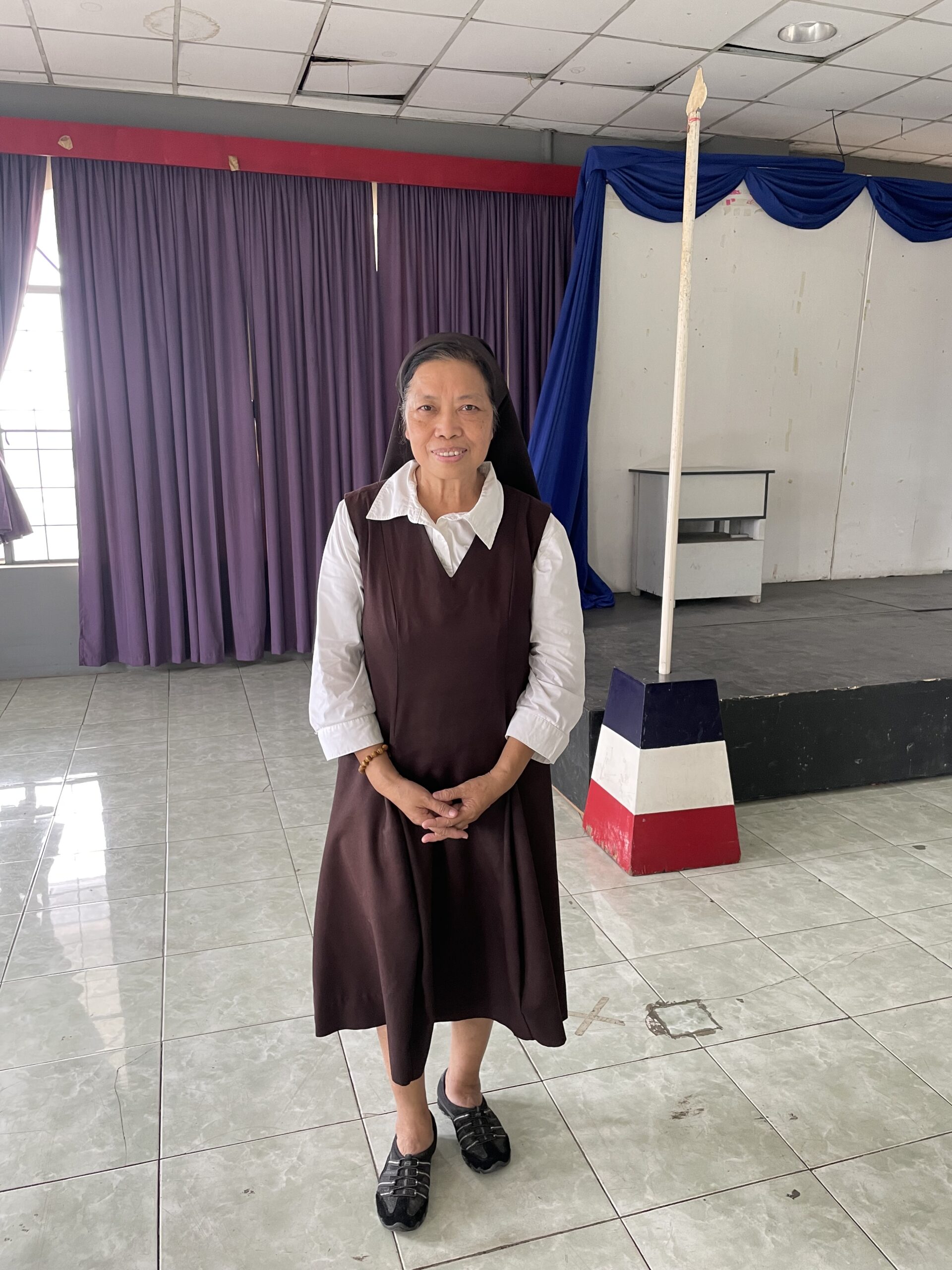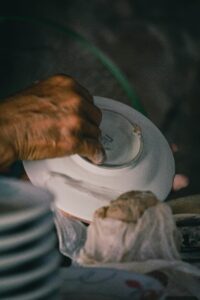Hello. Today we interviewed a priest and learned about her life. She is not just a priest; she has had a lot of experience throughout her life. Even though I am irreligious, her opinions were very interesting. I hope this article will bring you some stimulation. See you!
Who are you?
My name is Mary Linn Alfeche. My job is being a priest, and I belong to a religious community called the Carmelite Missionaries.

“The Carmelite Missionaries”
The Carmelite Missionaries were founded by Francisco Palau in 1860. Their mission is “to announce to the people that you, Church, are infinitely beautiful and lovable.” They are active around the world in fields like education, social intervention, and more. For example, they manage educational centers in Argentina, Central America, Chile, Colombia, Europe, the Philippines, India, and Peru.
https://www.carmelitasmisioneras.org/en/quienessomos
What is your job?
Specifically, I am not a typical priest. I work for a school called Capitol University as a priest. I manage the religious group within the school. I hold Mass and a recollection at the school monthly, so more students can feel God near them. Also, as a priest, I provide spiritual direction counseling. This counseling is for every person in the school. In these sessions, we talk about people’s lives and their concerns. This role is “school sister,” and we receive a salary because it is a contractual job with the school. Yet, my salary goes to my community as a fund. It’s okay for me because when I want to buy something or need more necessities, I can request money from them. But I try hard not to take too much, so they can use more funds for aid.
Why did you become a priest?
I was always in an environment where I could feel God close because my parents were devout Christians. However, the most decisive factor was attending a Christian school, where the teachers, who were sisters of Christ, became my role models.
What is good about being a school sister?
The best thing is that I feel very happy when young people grow closer to God through prayer.

What are your current problems?
1. Decrease in religious people
Many people here are Catholic, but there are also many from other religions because the Philippines is very open to different cultures and beliefs. I am a sister of the Catholic Church, so the Mass at Capitol University is Catholic. However, recently, the number of students attending Mass has decreased because more students belong to other religions or are irreligious. I don’t think having diversity is a bad thing, but it makes me feel a bit sad.

“About Irreligion”
Irreligion refers to not having a specific religion. It is completely different from atheism. Of course, most atheists are irreligious, but some theists are irreligious as well.
Increase in Irreligion: The number of irreligious people is increasing. According to a 2012 study, there are 1.1 billion irreligious people, making them the third largest group after Christians and Muslims. This increase is happening worldwide. For example, in France, 35% of citizens attended Mass every Sunday, but now only 5% do. In America, the percentage of irreligious people rose from 8% to 18% between 1990 and 2010.
Irreligion in the Philippines: Although the Philippines is a strongly Catholic country, since 2011, irreligion has been spreading, especially among younger generations. One in eleven Filipino Catholics are leaving the Church, and only 37% regularly attend Mass. While this may seem high compared to other countries, the number is declining. Additionally, anti-Catholic sentiment has grown in the Philippines, especially after President Duterte publicly criticized Catholic leaders, calling them “crazy.”
2. Religious discrimination
L: I mentioned that the Philippines is very open to different religions, right? But not all countries are as open. For example, I was dispatched to Indonesia as a Catholic sister for my community’s volunteer activities. During the 12 years I lived there, I faced a lot of discrimination due to my religion. Since most Indonesians are Muslim, I wasn’t able to find a job as a Catholic. There were literally no options. If an employer saw my résumé and my religion, they would reject me. I especially felt strong discrimination when wearing my Catholic vestments. Even though I was dispatched to a region where discrimination was less intense compared to other parts of Indonesia, children would still run away and hide when they saw me in my Catholic attire.

“Religious discrimination around the world”
There is a lot of religious abuse in many countries. Christians and Muslims face the most discrimination, partly due to the large numbers of their followers. However, religious minorities also face significant abuse.
Discrimination by governments: Religious discrimination is not only carried out by individuals or groups but also by governments. In 2018, Buddhists, Christians, Hindus, Muslims, and religiously unaffiliated people were all more likely to face government discrimination than individuals. Jews, in particular, reported harassment in 77 countries, with the governments of 59 of
these nations participating in that harassment. When governments engage in religious discrimination, people of minority faiths often struggle to find jobs, access public services, or receive aid.
Discrimination in Indonesia: Religious intolerance is rising in Indonesia, and incidents of conflict over religious freedom are increasing. The divide between different faiths is becoming more severe.
But this conflict didn’t arise without a trigger. In 2005, President Susilo Bambang Yudhoyono legitimized religious intolerance by vowing to impose strict regulations on “deviant” religions. This led to intense harassment of religious minorities. Even today, some of these hostile laws remain, such as the blasphemy law. This law is used to prosecute and imprison members of religious minorities and traditional religions. Severe religious discrimination will persist until these unjust regulations are reformed.

Two men hold the Indonesian flag as the compound of the Gafatar(religious movement with roots in Islam) sect burns after being set on fire by local villagers, at Antibar village, West Kalimantan province.
How do you think about discrimination?
I believe people should stop discriminating and disrespecting each other’s beliefs. Regardless of their faith, if people fight, there is no God present. God is always where there is peace and respect. Even if you have true faith, God does not want you to make others unhappy. If you live happily with others, God will always be there, no matter your religion or nationality.
What is your dream right now?
To return to volunteer missions.
Although I experienced discrimination while volunteering, the experiences were deeply rewarding and remain cherished memories.
What is your favorite word?
In God I trust
sources, pictures
・Education – Carmelite Missionary Sisters (carmelitasmisioneras.org)
https://www.carmelitasmisioneras.org/en/educacion
・無宗教 – Wikipedia https://ja.wikipedia.org/wiki/無宗教
・Religious Affiliation in the Philippines (2020 Census of Population and Housing) | Philippine Statistics Authority | Republic of the Philippines (psa.gov.ph)
https://psa.gov.ph/content/religious-affiliation-philippines-2020-census-population-and-housing
・Indonesia’s Religious Minorities Under Threat | Human Rights Watch (hrw.org)
・Harassment of religious groups continues in more than 90% of countries | Pew Research Center
・https://communications.catholic.edu/_media/2018-news-photos/massofholyspirit_2018_00022-1200x.jpg





